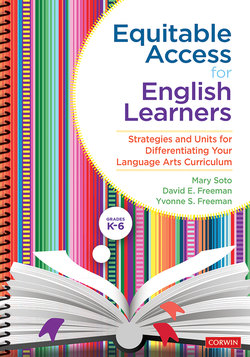Читать книгу Equitable Access for English Learners, Grades K-6 - Mary Soto - Страница 43
На сайте Литреса книга снята с продажи.
Drawing on Students’ Home Languages—Translanguaging
ОглавлениеThe common-sense practice that has been widely used in both ESL and bilingual classrooms is to keep students’ home languages separate from instruction in English. During ESL classes, teachers and students only speak English. In many bilingual classes, only English is used in designated English time and Spanish or another language is used exclusively during the time designated for that language. Teachers have been encouraged not to mix languages as they teach. However, research supports the use of students’ home languages to help them learn English and to learn academic content in English (Creese & Blackledge, 2010; Cummins, 2007; García, 2009). The practice of using both languages in instruction is referred to as translanguaging.
Research in sociolinguistics has shown that in bilingual communities, people regularly use both their home language and the language of the country. In many communities in the United States, it is common to hear people speaking English and Spanish, English and Korean, English and Arabic, or English and Mandarin. In addition, research in neurolinguistics has shown that, in bilingual people, both (or all) their languages are always active, a bit like an application that continues to run in the background on a smartphone.
Based on extensive observations in classrooms with English learners, García, Johnson, and Seltzer (2017) have shown that teachers can make strategic use of students’ home languages as a scaffold to help them develop academic English proficiency. Based on this research, García and her colleagues have developed a theory of dynamic bilingualism. They explain:
We use the metaphor of the translanguaging corriente to refer to the current or flow of students’ dynamic bilingualism that runs through our classrooms and schools. Bilingual students make use of the translanguaging corriente either covertly or overtly to learn content and language in school and to make sense of their complex worlds and identities. (21)
Instead of looking at bilinguals as two monolinguals in one person, García (2009) argues that bilinguals have just one language repertoire, and the use of either language adds to this reservoir of language. Students can draw on this reservoir to make sense of instruction, read complex texts, and discuss and write about them.
Picture, then, a classroom of students. In it there are students of several different language backgrounds. As a class is conducted in English, a kind of invisible current of students’ knowledge in their home languages is running, and bilingual children, when allowed and encouraged, can draw on their full linguistic repertoire to make sense of the instruction in English.
